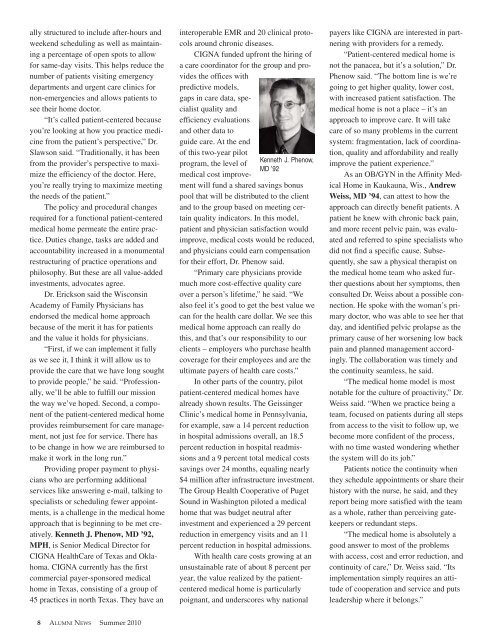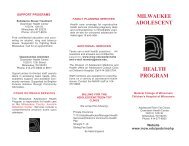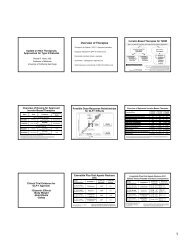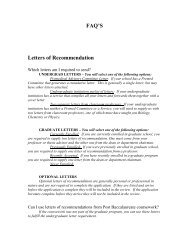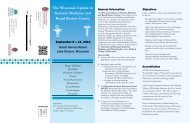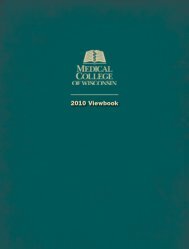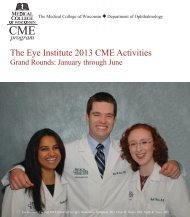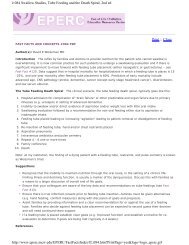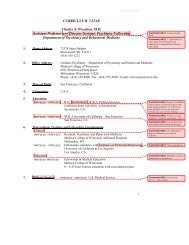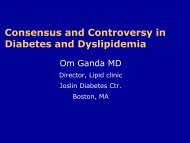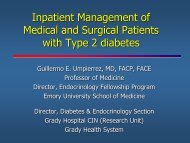Summer 2010 issue (pdf) - Medical College of Wisconsin
Summer 2010 issue (pdf) - Medical College of Wisconsin
Summer 2010 issue (pdf) - Medical College of Wisconsin
Create successful ePaper yourself
Turn your PDF publications into a flip-book with our unique Google optimized e-Paper software.
ally structured to include after-hours and<br />
weekend scheduling as well as maintaining<br />
a percentage <strong>of</strong> open spots to allow<br />
for same-day visits. This helps reduce the<br />
number <strong>of</strong> patients visiting emergency<br />
departments and urgent care clinics for<br />
non-emergencies and allows patients to<br />
see their home doctor.<br />
“It’s called patient-centered because<br />
you’re looking at how you practice medicine<br />
from the patient’s perspective,” Dr.<br />
Slawson said. “Traditionally, it has been<br />
from the provider’s perspective to maximize<br />
the efficiency <strong>of</strong> the doctor. Here,<br />
you’re really trying to maximize meeting<br />
the needs <strong>of</strong> the patient.”<br />
The policy and procedural changes<br />
required for a functional patient-centered<br />
medical home permeate the entire practice.<br />
Duties change, tasks are added and<br />
accountability increased in a monumental<br />
restructuring <strong>of</strong> practice operations and<br />
philosophy. But these are all value-added<br />
investments, advocates agree.<br />
Dr. Erickson said the <strong>Wisconsin</strong><br />
Academy <strong>of</strong> Family Physicians has<br />
endorsed the medical home approach<br />
because <strong>of</strong> the merit it has for patients<br />
and the value it holds for physicians.<br />
“First, if we can implement it fully<br />
as we see it, I think it will allow us to<br />
provide the care that we have long sought<br />
to provide people,” he said. “Pr<strong>of</strong>essionally,<br />
we’ll be able to fulfill our mission<br />
the way we’ve hoped. Second, a component<br />
<strong>of</strong> the patient-centered medical home<br />
provides reimbursement for care management,<br />
not just fee for service. There has<br />
to be change in how we are reimbursed to<br />
make it work in the long run.”<br />
Providing proper payment to physicians<br />
who are performing additional<br />
services like answering e-mail, talking to<br />
specialists or scheduling fewer appointments,<br />
is a challenge in the medical home<br />
approach that is beginning to be met creatively.<br />
Kenneth J. Phenow, MD ’92,<br />
MPH, is Senior <strong>Medical</strong> Director for<br />
CIGNA HealthCare <strong>of</strong> Texas and Oklahoma.<br />
CIGNA currently has the first<br />
commercial payer-sponsored medical<br />
home in Texas, consisting <strong>of</strong> a group <strong>of</strong><br />
45 practices in north Texas. They have an<br />
interoperable EMR and 20 clinical protocols<br />
around chronic diseases.<br />
CIGNA funded upfront the hiring <strong>of</strong><br />
a care coordinator for the group and provides<br />
the <strong>of</strong>fices with<br />
predictive models,<br />
gaps in care data, specialist<br />
quality and<br />
efficiency evaluations<br />
and other data to<br />
guide care. At the end<br />
Kenneth J. Phenow,<br />
MD ’92<br />
<strong>of</strong> this two-year pilot<br />
program, the level <strong>of</strong><br />
medical cost improvement<br />
will fund a shared savings bonus<br />
pool that will be distributed to the client<br />
and to the group based on meeting certain<br />
quality indicators. In this model,<br />
patient and physician satisfaction would<br />
improve, medical costs would be reduced,<br />
and physicians could earn compensation<br />
for their effort, Dr. Phenow said.<br />
“Primary care physicians provide<br />
much more cost-effective quality care<br />
over a person’s lifetime,” he said. “We<br />
also feel it’s good to get the best value we<br />
can for the health care dollar. We see this<br />
medical home approach can really do<br />
this, and that’s our responsibility to our<br />
clients – employers who purchase health<br />
coverage for their employees and are the<br />
ultimate payers <strong>of</strong> health care costs.”<br />
In other parts <strong>of</strong> the country, pilot<br />
patient-centered medical homes have<br />
already shown results. The Geissinger<br />
Clinic’s medical home in Pennsylvania,<br />
for example, saw a 14 percent reduction<br />
in hospital admissions overall, an 18.5<br />
percent reduction in hospital readmissions<br />
and a 9 percent total medical costs<br />
savings over 24 months, equaling nearly<br />
$4 million after infrastructure investment.<br />
The Group Health Cooperative <strong>of</strong> Puget<br />
Sound in Washington piloted a medical<br />
home that was budget neutral after<br />
investment and experienced a 29 percent<br />
reduction in emergency visits and an 11<br />
percent reduction in hospital admissions.<br />
With health care costs growing at an<br />
unsustainable rate <strong>of</strong> about 8 percent per<br />
year, the value realized by the patientcentered<br />
medical home is particularly<br />
poignant, and underscores why national<br />
payers like CIGNA are interested in partnering<br />
with providers for a remedy.<br />
“Patient-centered medical home is<br />
not the panacea, but it’s a solution,” Dr.<br />
Phenow said. “The bottom line is we’re<br />
going to get higher quality, lower cost,<br />
with increased patient satisfaction. The<br />
medical home is not a place – it’s an<br />
approach to improve care. It will take<br />
care <strong>of</strong> so many problems in the current<br />
system: fragmentation, lack <strong>of</strong> coordination,<br />
quality and affordability and really<br />
improve the patient experience.”<br />
As an OB/GYN in the Affinity <strong>Medical</strong><br />
Home in Kaukauna, Wis., Andrew<br />
Weiss, MD ’94, can attest to how the<br />
approach can directly benefit patients. A<br />
patient he knew with chronic back pain,<br />
and more recent pelvic pain, was evaluated<br />
and referred to spine specialists who<br />
did not find a specific cause. Subsequently,<br />
she saw a physical therapist on<br />
the medical home team who asked further<br />
questions about her symptoms, then<br />
consulted Dr. Weiss about a possible connection.<br />
He spoke with the woman’s primary<br />
doctor, who was able to see her that<br />
day, and identified pelvic prolapse as the<br />
primary cause <strong>of</strong> her worsening low back<br />
pain and planned management accordingly.<br />
The collaboration was timely and<br />
the continuity seamless, he said.<br />
“The medical home model is most<br />
notable for the culture <strong>of</strong> proactivity,” Dr.<br />
Weiss said. “When we practice being a<br />
team, focused on patients during all steps<br />
from access to the visit to follow up, we<br />
become more confident <strong>of</strong> the process,<br />
with no time wasted wondering whether<br />
the system will do its job.”<br />
Patients notice the continuity when<br />
they schedule appointments or share their<br />
history with the nurse, he said, and they<br />
report being more satisfied with the team<br />
as a whole, rather than perceiving gatekeepers<br />
or redundant steps.<br />
“The medical home is absolutely a<br />
good answer to most <strong>of</strong> the problems<br />
with access, cost and error reduction, and<br />
continuity <strong>of</strong> care,” Dr. Weiss said. “Its<br />
implementation simply requires an attitude<br />
<strong>of</strong> cooperation and service and puts<br />
leadership where it belongs.”<br />
8 ALUMNI NEWS <strong>Summer</strong> <strong>2010</strong>


